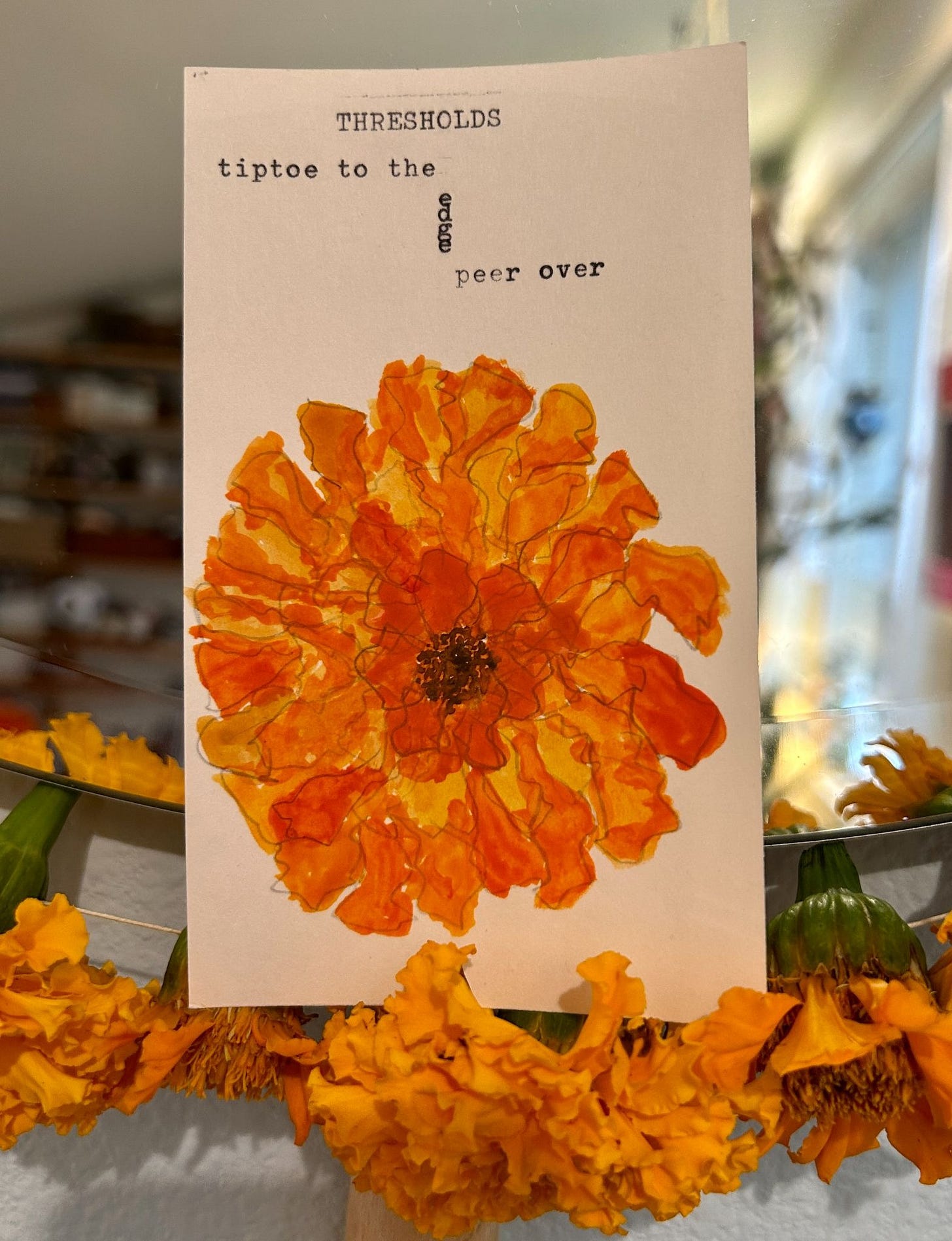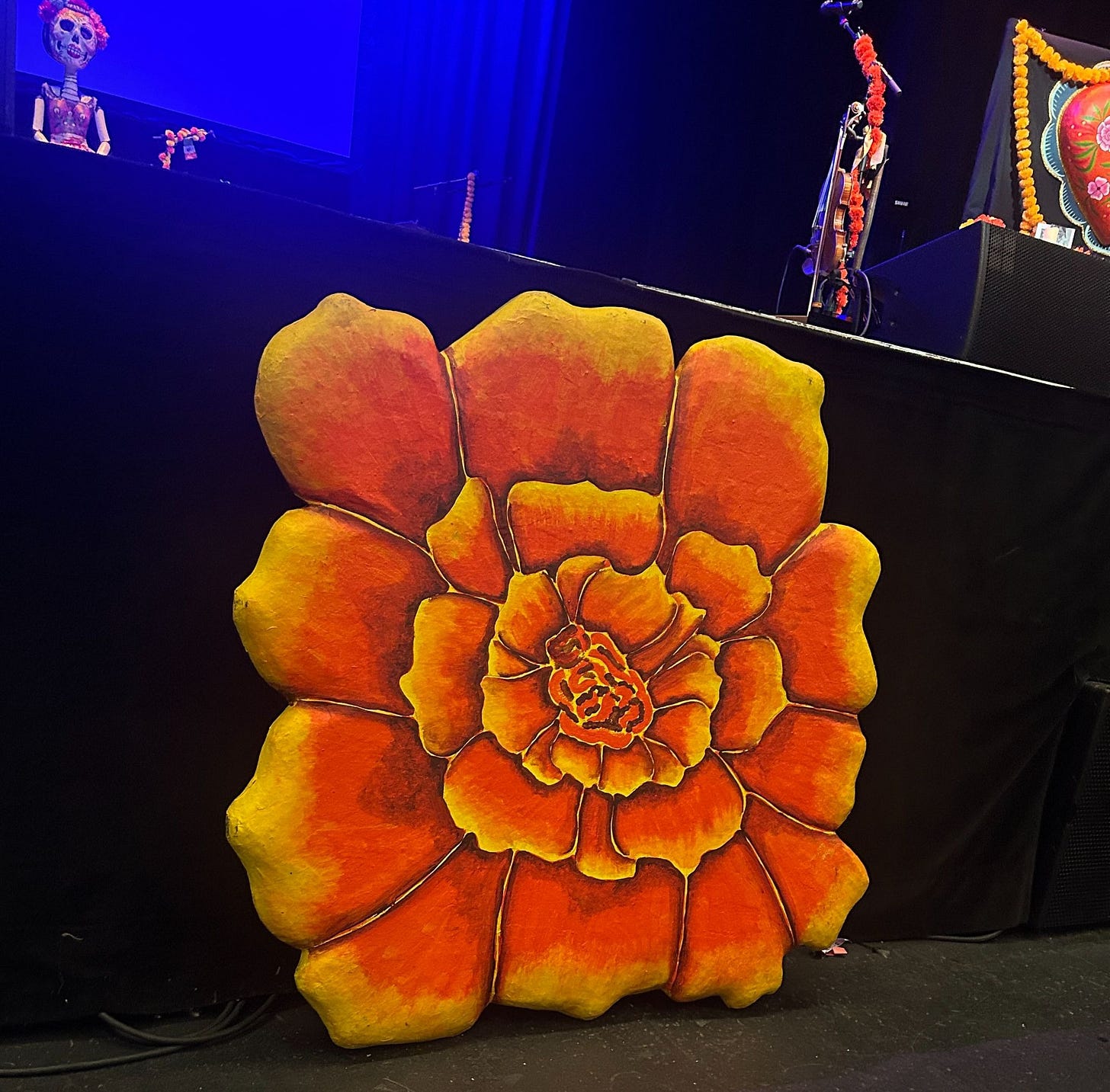Estuaries, Borders, & Gap Edges: The Necessity of Creative Disruption
(plus a prompt for exploring thresholds)

“The gap edges, or ecotones, where two ecosystems, the new and the old, meet, are among the most diverse and productive ecosystems…There are species that live in neither the new nor the old, but at the edges.”
-Robin Wall Kimmerer, The Serviceberry: Abundance and Reciprocity in the Natural World
Our town, Olympia, is located where the Puget Sound meets the Deschutes River. In 1951, this estuary was dammed to make a reflection lake for the Washington State Capitol. According to the Washington State Department of Ecology, “By the early 1970s, the lake suffered from excessive sediment deposition, algal blooms, and overgrowth of invasive aquatic plants.” Despite heavy criticism, in 2022, the Deschutes Estuary Restoration Project was launched. God(s) willing and the crick don’t rise, the gap edge that is the Deschutes Estuary will be restored. The ecosystem and critters who thrive where the sea and the river mingle will begin to heal as the natural flow of the estuary is returned, and the waters are once again oxygenated.
Dams are not so different from national borders. Borders threaten the natural flow of ideas and cultural cross-pollination. Borders encourage scarcity and fear, and fear becomes an invasive species, smothering the capacity for curiosity and generosity, shutting down the potential for the explosive abundance that is cultural cross-pollination.
In The Serviceberry, Robin Wall Kimmerer writes, “Disruptions create gaps, openings and edges between the new and the dominant…[I]ncremental change and creative disruption…are available to us as agents of cultural transformation.” Estuaries, with their brackish water, embody the gap edges of creative disruption. The ingenuity and adaptation of the creatures who live in estuaries (and other gap edges) makes them diverse and vibrant, but it also makes them vulnerable to ocean acidification, droughts, and human developments, like the dam that blocks the flow of water between the Deschutes River and Puget Sound. These all add to the precariousness of estuaries. Immigrants, who embody the cultural flow between the old and the new, what was and what might be, often experience a sense of precariousness, too. They are representations of cultural hopes and cultural fears, carrying the weight of change and the burden of history.
We are at a cultural and humanitarian threshold. In order to cross this threshold and live in a world where borders become more like the brackish water of an estuary, and humans, no matter their nationalities, are supported and respected, we need the to use creative disruption as a tool for cultural transformation. Right now this idea is only a faint imprint in my imagination, but I think Robin Wall Kimmerer is on to something. Places that are gap edges can teach us about creative disruption. Perhaps we need to start thinking like an estuary.
Transitional periods are fragile. Our ecosystems are in disarray. The pain of growth, if we can move through it with tenderness and attentive patience, can lead to transformations, but we have to be willing to step into the gap edge that holds both what we fear letting go of and the potential of what we can become.
a prompt for playing with creative disruption and wading into the gap edge of a threshold

A couple of weeks ago, I went to Seattle to see the band Las Cafeteras. I had no idea I was walking into the gap edge of performance as communal mourning, remembrance, and celebration. Las Cafeteras describe their music as “document[ing] stories of a community seeking to ‘build a world where many worlds fit.’” Talk about an estuary. Talk about creative disruption. Talk about art as a form of political resistance and community building. Talk about a joyful middle finger to the cultural forces that are trying to destroy the memories and stories that make up the estuary of our shared humanity.
Multi-modal art, like the Las Cafeteras performance “ Hasta la Muerte,” explores the potential of the gap edge. Jenn and I, too, are conducting experiments in the gap edge that is Joyful Practice. (Note to Jenn: It just occurred to me that if creative disruption is our hypothesis, then Joyful Practice is our lab.)
A few days ago, Jenn asked me if there is a difference between thresholds and convergence. This work of seeking out the estuarine spaces where grief mingles with joy, analog is in relationship with digital, and creative disruptions come in the form of making things imperfectly, humanly, and with our bodies as our guides (instead of machines) is both a convergence and a threshold. Maybe when things converge, they create new thresholds. Maybe the gap edge, which is both a place of convergence and a threshold, offers a lens for thinking about Jenn’s question.
Here’s an example: when I went to the Las Cafeteras performance, it was the day after the anniversary of my sister’s death, and I felt tender and exhausted, anxious about being somewhere so public while my wounds felt so exposed. When La Muerte (the embodiment of death) asked La Llorona (the weeping woman who drowned her children) if she could forgive herself, and La Llorona said yes, and La Muerte gently took her by the arm, I understood her heartbreak as the heartbreak of my own grieving mother. In that moment, my mother was La Llorona, and so was I. The re-imagining of La Llorona’s story converged with my own experiences and offered a new way to consider my relationship to my mother (and to myself as a mother).
When La Muerte offered safety and a final resting place to a migrant who died crossing the desert next to the border that separates Texas, my first home, from Mexico, the place where my sisters’ father’s family came from, I felt a collective heartbreak for the migrants who risk so much and the immigrants who live in fear, whose lives and families have been upended by dehumanization, cruel policies, and xenophobia.
Within the swirl of these stories, a threshold emerged, and for the first time in fifteen years, I saw the glimmering possibility that, at the moment of her death, La Muerte offered my sister, and so many others, peace, forgiveness, and an end to suffering. My tender, grieving body found solace in the act of collective mourning and celebration.
Here’s my prompt for you this week:
This phrase has haunted me all week: The brackish water/where we swim/teeming with the silver-scaled thrust of something new. I think I dreamt it, or maybe it bubbled up as I was between waking and sleeping.
Imagine your creative self is in the brackish water of an estuary, an ecosystem of explosive abundance and creative disruption. What stories are swimming with you? What are the old parts that need re-imagining, so you can embrace the “silver-scaled thrust of something new?”
What is converging right now? What new thresholds might emerge out of this convergence?
What are the gap edges in your own creative process? What is the creative disruption brewing in those gap edges?
What does a world where “many worlds fit” look like?
PS: A podcast recommendation: “Whose Borscht is it Anyway?” (from the Podcast Proof).
Of course, food, too, behaves like an estuary, adapting and evolving with the ebb and flow of cultural migrations and political reverberations.
What if everything good comes from estuarine spaces (and all the other gap edges)? (This, too, could become a prompt.)



Absolutely beautiful post. The Serviceberry has been one of the most impactful books I've read this year and thinking about metaphorical ecotones as sources of creativity is another powerful idea from it that I hadn't considered. I also really love your prompts--I will be using them in my journaling practice!